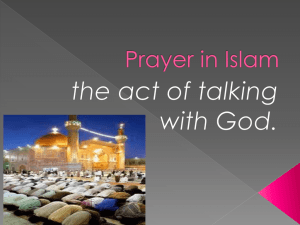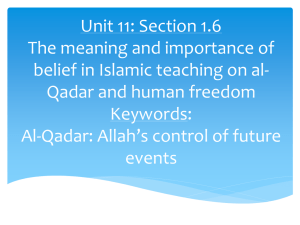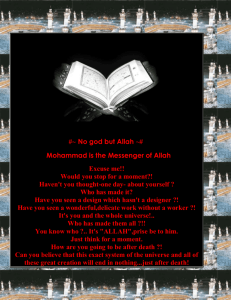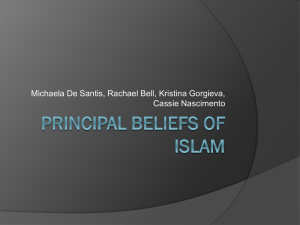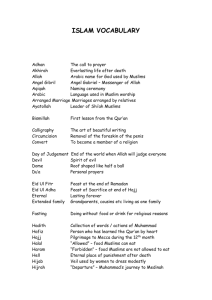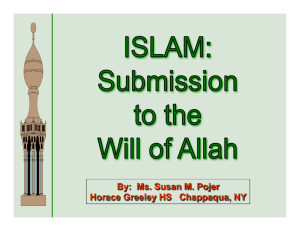Teaching about Islam-Challenging Isuues
advertisement
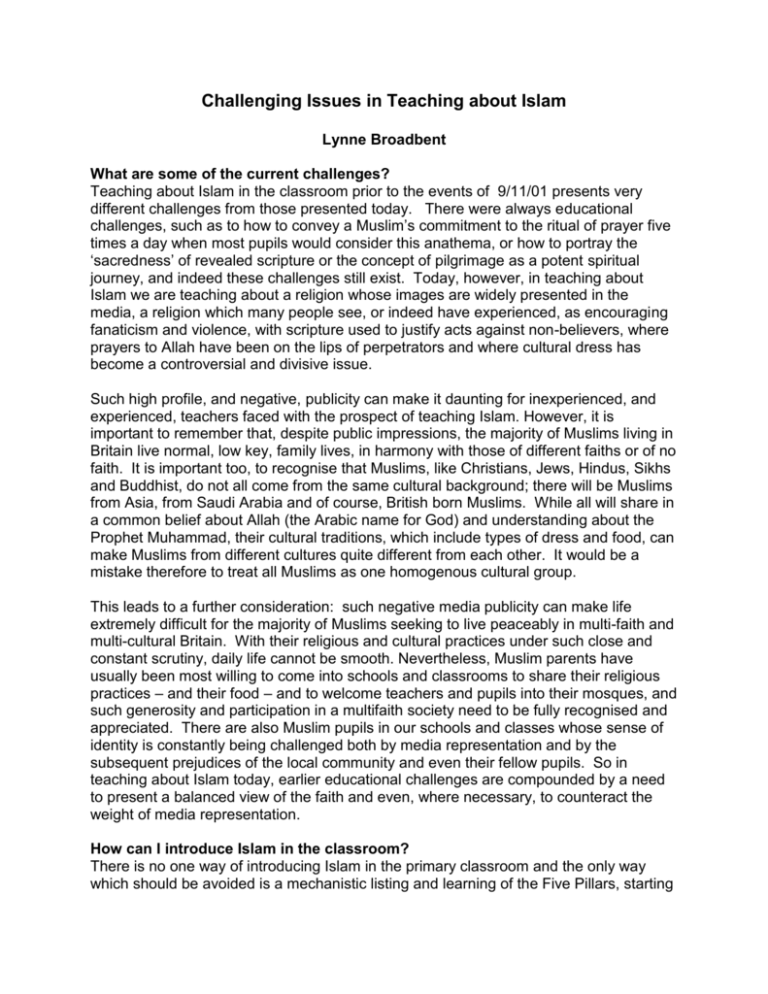
Challenging Issues in Teaching about Islam Lynne Broadbent What are some of the current challenges? Teaching about Islam in the classroom prior to the events of 9/11/01 presents very different challenges from those presented today. There were always educational challenges, such as to how to convey a Muslim’s commitment to the ritual of prayer five times a day when most pupils would consider this anathema, or how to portray the ‘sacredness’ of revealed scripture or the concept of pilgrimage as a potent spiritual journey, and indeed these challenges still exist. Today, however, in teaching about Islam we are teaching about a religion whose images are widely presented in the media, a religion which many people see, or indeed have experienced, as encouraging fanaticism and violence, with scripture used to justify acts against non-believers, where prayers to Allah have been on the lips of perpetrators and where cultural dress has become a controversial and divisive issue. Such high profile, and negative, publicity can make it daunting for inexperienced, and experienced, teachers faced with the prospect of teaching Islam. However, it is important to remember that, despite public impressions, the majority of Muslims living in Britain live normal, low key, family lives, in harmony with those of different faiths or of no faith. It is important too, to recognise that Muslims, like Christians, Jews, Hindus, Sikhs and Buddhist, do not all come from the same cultural background; there will be Muslims from Asia, from Saudi Arabia and of course, British born Muslims. While all will share in a common belief about Allah (the Arabic name for God) and understanding about the Prophet Muhammad, their cultural traditions, which include types of dress and food, can make Muslims from different cultures quite different from each other. It would be a mistake therefore to treat all Muslims as one homogenous cultural group. This leads to a further consideration: such negative media publicity can make life extremely difficult for the majority of Muslims seeking to live peaceably in multi-faith and multi-cultural Britain. With their religious and cultural practices under such close and constant scrutiny, daily life cannot be smooth. Nevertheless, Muslim parents have usually been most willing to come into schools and classrooms to share their religious practices – and their food – and to welcome teachers and pupils into their mosques, and such generosity and participation in a multifaith society need to be fully recognised and appreciated. There are also Muslim pupils in our schools and classes whose sense of identity is constantly being challenged both by media representation and by the subsequent prejudices of the local community and even their fellow pupils. So in teaching about Islam today, earlier educational challenges are compounded by a need to present a balanced view of the faith and even, where necessary, to counteract the weight of media representation. How can I introduce Islam in the classroom? There is no one way of introducing Islam in the primary classroom and the only way which should be avoided is a mechanistic listing and learning of the Five Pillars, starting with the Shahada (the statement of belief) and moving rapidly through Salat (prayer), zakat (charity), Sawm (fasting) and concluding with Hajj (pilgrimage). Such an approach of taking key concepts and trying to cover them all in a short scheme of work rarely does justice to the rich daily experience of a Muslim – and indeed such an approach would not do justice to any other religion either. Selecting a series of lessons on Islam may be governed by the local agreed syllabus or the diocesan syllabus; if for example, the syllabus indicates a topic on ‘Special Books’ or ‘A Place of Worship’ in Key Stages 1 or 2, then the Qur’an or the mosque will provide a starting point for learning. If asked, the majority of Muslims would say that the most important aspect of Islam is belief in Allah and this should therefore be the first thing taught. However, to begin with the concept of God could be just too abstract for most pupils at Key Stage 1 or 2. An approach through prayer, the Arabic word being ‘salat’, offers an opportunity to introduce the complex concepts of Allah, the ritual of prayer and submission to the Will of Allah through the discussion of an artefact, the prayer mat. Why is prayer so important in Islam and how can I teach about it? For religious believers, artefacts are not decorative additions but essential to their rituals and thereby beliefs, so it is worthwhile planning a sequence of progressively probing questions to enable pupils to explore, at a level appropriate to their age, all the aspects of faith and ritual associated with the artefact displayed. For a prayer mat, questions might include: What can you see/not see? Who might use this mat, and why? In what direction would you place it? and How would you prepare to use the prayer mat and how would you use it? Most prayer mats show images of mosques, minarets and/or geometric shapes and leaf and flower motifs. At Key Stage 1, an initial approach might include learning about the muezzin giving the Call to Prayer (the adhan) from the minaret, noticing and replicating the designs on the prayer mat and learning how the leaf and flower designs acknowledge that, for Muslims, Allah is Creator. This then enables younger pupils, often with limited knowledge of prayer as a religious activity, to begin to understand prayer as worshipping Allah as Creator of the world. There are opportunities here for a celebration of the natural world through exploring, drawing, photographing and collecting images and specimens – all opportunities for awe and wonder, whether or not this is defined or described in a religious context. Videos aimed at Key Stage 1 showing young children praying with their families readily convey the calm and focused atmosphere of prayer and the need to prepare for this through ‘wuzu’, the ritual washing of hands, feet and face, the outer cleanliness symbolising an inner cleanliness as preparation or readiness for prayer. Examples of washing the hands before meals or before touching a precious item have long been used in the classroom but this tends to be a rather superficial link and it is the stilling exercises used before circle time to encourage a quiet, reflective attitude which can be more helpful analogies. With older pupils, the challenge is to develop a deeper understanding of what prayer five times a day means in the life of a Muslim and how a Muslim’s relationship with Allah is reflected in the positions of prayer. Of course the easiest and most effective means of doing this would be call on a Muslim colleague or parent, confident and courageous enough to share their experiences of prayer with the children. Alternately, while the five times of daily prayer (dawn, midday, late afternoon, sunset and night) do not coincide with the school day, it might be possible to identify three points during the day when pupils stop what they are doing and focus, even more a few minutes, on a person who is important to them and think about how that experience of regularly bringing someone to mind affects them. A ‘muslim’ is one who submits to the will of Allah and prostration during prayer clearly symbolises this. Looking at pictures of people from different religions at prayer can an effective discussion starter on the links between the experience of prayer and bodily posture. In some faiths, prayer is undertaken while kneeling or standing, hands may be raised in the air or the sign of the cross made. Starting with an artefact and identifying clearly focused questions, complex rituals and beliefs can be explored even with younger pupils. There are many other areas of teaching linked to a topic on prayer which have not been considered above, for example, the story of Bilal, the African slave who refused to deny his Muslim faith even when persecuted by his employer, who became the first muezzin, a study of the words of the Adhan or Call to Prayer itself and of course Muslim belief in Allah which is explored below. How can I meet the challenge of teaching about Allah? ‘There is no god except Allah; Muhammad is the messenger of Allah’ This is the Shahadah, the declaration of belief recited by every Muslim. It declares Muslim belief in the oneness of Allah, the Arabic word ‘Allah’ meaning ‘the God’. A Muslim RE teacher described how, travelling through Jordan, she met an elderly Christian, Arabic speaking, nun and both the Muslim and the Christian found themselves using the term ‘Allah’ when talking about God. Whatever the similarities in use of the term ‘Allah’, there are clear distinctions between Muslim and Christian understandings of God. For Muslims, belief in the oneness of Allah, the Arabic term for this being ‘Tawhid’, indicates a belief in an indivisible God, without partners and without equals. Christian belief in God as Father, Son and Holy Spirit is therefore totally contrary to Muslim belief and thought. For Muslims, only Allah must be worshipped and to worship anything other than Allah is ‘shirk’ or sin. A Muslim believes in Allah as the Creator of everything on earth, surrendering him/herself to the will of Allah in the knowledge that after death all things return to Allah. Therefore the very purpose of life for Muslims is to fulfil the will of Allah, and it is at this point that the Five Pillars become significant for these idnrify the main duties of a Muslim through which he/she finds favour with Allah. For Muslims, everything that happens, happens with the knowledge and will of Allah; indeed, the Arabic phrase for ‘If Allah wills…’ is constantly said when arrangements are made for future events. This does not mean that humans do not have free will, they have the freedom to choose whether or not to follow the will of Allah, but they do so knowing that on the Day of Judgement they will be judged for their actions on earth. Meanwhile, humans know that they are ‘khalifa’, the agents of Allah on earth, and must live out their beliefs in their daily lives, caring for the world which Allah has created. Developing knowledge and understanding about God with pupils, whether from a religious or non-religious background, is never an easy matter. Here however, Islam is helpful to teachers having to meet this challenge, for although the Oneness of Allah is central to Muslim belief, Muslims refer to the 99 Names or attributes of Allah . Unpacking the symbolism of the attributes of Allah can be invaluable starting point. Allah is the ‘The Creator’, ‘The Source of Peace’, ‘The Loving’, ‘The All-Forgiving’, ‘The All-Knowing’, the ‘All-Wise’ and ‘All-Powerful’; Allah is also ‘The Guide’ and ‘The Protecting Friend’. Reflection and discussion on the meaning of some of these names for Muslims could be a Circle Time activity, however it should be remembered that Muslims would never represent Allah visually and it would be totally inappropriate to do so in the classroom. For Muslims, learning about Allah’s will for human beings comes from studying the Qur’an and from stories about, and examples from the life of the Prophet Muhammad. How and what can I say about the Prophet Muhammad? ‘There is no god except Allah; Muhammad is the Messenger of Allah’ The second part of the Shahadah refers to the Prophet Muhammad and to the second significant concept in Islam, that of ‘risalah’ or ‘prophethood’. Learning about the prophets is rarely included in RE syllabuses today and consequently we have lost the reference point for a powerful religious concept. The Jewish prophets, such as Hosea and Amos, were men who spoke on behalf of God, a channel of communication between God and humans. They were men who challenged the status quo, criticising the values and practices of the people of the time and urging them to refocus on the centrality of God and live moral lives. These are all features of the life of the Prophet Muhammad. Muhammad was born in 571 CE into the noble Quraish tribe in Makkah, Arabia. His father died before he was born and his mother died when he was six years old, so Muhammad was brought up by his uncle, Abu Talib. When young, Muhammad looked after sheep, as had the prophet Moses, but when he was twenty-five years old he married Khadijah and became involved in her business, buying and selling goods. Muhammad and Khadijah had six children. There was much conflict between the different tribes around Makkah at that period, the tribes worshipping different gods or idols and only agreeing to the cessation of conflict during the pilgrimage season when all came to Makkah to trade. Muhammad would retreat to the hills and in particular to a cave, Hira, to meditate alone. It was at the age of forty, when, during one of these retreats, the angel Jibra’il appeared and commanded him to ‘Read’. Muhammad said he could not read or write, but the angel hugged him firmly and repeated the command. At the third command of the angel, Muhammad began to recite what was to become the revelation of the first verses of the Qur’an (appearing in print as surah 96: 1-5) beginning ‘Read in the name of your Lord…’ When the angel left him, Muhammad ran home terrified and it was Khadijah who reassured him that he was to be Allah’s prophet. The revelations of the Qur’an continued over a period of many years. In the summary above, there are two issues which present difficulties for non-Muslim audiences and in particular, for teaching; first, the character of a person who is to be a prophet and second the issue of direct revelation from Allah. The notion of a prophet can seem very remote but here in the person of Muhammad, is a family man living in a busy city and working as a trader, a helpful picture to paint for children at Key Stages 1 & 2, and a picture which can be supported by the later stories of his care for animals such as the crying camel, the kittens who fell asleep on his cloak and the ants whom he saved from the fire. The issue of a direct revelation from Allah is quite different. This cannot be explained away, nor can we provide an analogy to help children understand – while we can discuss whether revelations are visual or in the mind, a revelation is a revelation and that is part of our teaching about religion. That is true with the Prophet Muhammad, Moses and the burning bush or Guru Nanak’s disappearance in the river. Following the revelations, Muhammad began to preach the oneness of Allah, at first to his immediate family and community and then more widely. His message was not welcomed or accepted by the Makkans who became hostile and Muhammad’s life was in danger. After many years of difficulties and periods of emigration, Muhammad and his followers travelled to Madinah to establish the first Muslim community and it is from this year, 622CE, that Muslims date their calendar. For Muslims, the Prophet Muhammad is respected as a man, as the Prophet of Allah but he is not worshipped. What about the other prophets of Islam, and Judaism and Christianity? While media coverage of Islam is keen to highlight ‘difference’, it is less willing to acknowledge its similarities and commonalities with other religions, yet Islam shares a strong historical relationship with Judaism and Christianity through the prophets. According to Muslim belief, from the time of Creation, Allah has sent guidance for humans through His prophets and these are the prophets acknowledged by Judaism, Christianity and Islam. All three religions identify their roots in Abraham (in Arabic, Ibrahim) and prophets such as Noah (Nuh), Job (Ayyub), Moses (Musa) and John (Yahya) and Muslims acknowledge Jesus (Isa) as a prophet, although not regarding him as divine. For Muslims, Muhammad is the final prophet of Allah, the Seal of the Prophets, and because his message was the direct revelation from Allah, unaltered and unadulterated by humans, there is no need for any further prophet. Stories of these prophets are found in the Qur’an and teachers can find simple and colourful retellings of their lives and actions in the many books produced for children. There are however, some differences in the stories from those found in the Christian Bible and teachers will need to be alert to this; for example, while Jews and Christians tell the story about Abraham planning to sacrifice his only son Isaac in obedience to God (Genesis 22), for Muslims, the only time when Ibrahim had one son, it was Ishmail, his son with Hagar and so the story about the sacrifice is told about Ibrahim and Ishmail (Surah 37) The Qur’an: Is this a difficult challenge for the teacher? When teaching about the Qur’an, there are three aspects to consider: first, the revelation of the Qur’an to the Prophet Muhammad, second, how the Qur’an is regarded and treated by Muslims, and third, what the Qur’an contains. The first revelation of the Qur’an has been described above; however, the complete Qur’an was revealed over a period of twenty-three years and memorised and recorded by Muhammad and his followers. When the Qur’an was finally recorded into one book, the revelations were compiled according to length, from longest to shortest, the first revelation being chapter or surah 96. The Qur’an contains guidance for living the life of a good Muslim, that is, in submission to the will of Allah. Some of this guidance for life lies in following the five pillars, other guidance directs Muslims on the treatment of others and some of these verses, in translation, are accessible to pupils at Key Stage 2 : for example, ‘Be kind to your parents and the relatives and the orphans and those in need and speak nicely to people’ (2.83) ‘Keep your promise…’ (17.34) ‘Practice forgiveness…’ (7.199) ‘Be kind as Allah has been kind to you…’ (28.77) It is often difficult to enable pupils to work directly with the text of sacred scripture but paired and small group discussions on the meaning of the above statements and displayed examples of how they might be enacted in daily life present such opportunities for RE to contribute to the development of literacy. As the revealed word of Allah, the Qur’an is treated with utmost respect by Muslims, usually wrapped in a cloth when not being read and kept on a high shelf so that nothing is above it. Reading the Qur’an is worship and Muslims will wash their hands and, in the case of women, cover their head before touching the Qur’an. A translation of the Qur’an in English is not regarded as highly as a copy of the Qur’an in Arabic. A teacher will need to model this respect in the classroom while still allowing pupils to actually see the beautifully written and decorated texts of the Qur’an. During Ramadan, and especially towards the end of the period of fasting on Lailat-ul-Qadr, the Night of Power, marking the first revelation of the Qur’an to Muhammad, Muslims will spend the night praying and studying the Qur’an. Ramadan might be a time when stories and sayings from the Qur’an could provide a focus for RE, for too frequently, teaching about Ramadan is restricted to learning about the prohibitions of going without food and drink during daylight hours. Codes of dress: Are these not a controversial challenge? In recent times, the media has often presented the wearing of hijab as defining a Muslim woman and the status of women in general in Islam. The reality is somewhat different from this. Firstly, in terms of dress, the requirement for both men and women is that they should dress modestly that is, without drawing attention to the shape of their bodies through their dress. Secondly, the way in which this requirement is implemented depends on a number of factors such cultural background of the woman, the culture in which she lives, her age and her attitude and response to her religious responsibility. There will therefore be Muslim women wearing full hijab, others wearing skirts and trousers and covering their heads and some not covering their heads. It does seem strange that today so many Western women can walk around in towns and cities bearing copious amounts of flesh without challenge while those who choose to cover themselves raise suspicion. In terms of the status of Muslim women, the only point of reference can only be statements in the Qur’an, statements of the Prophet and discussions with Muslim women themselves. The prophet held women as wives and mothers in high esteem and in Islam women have long held the right to own property, to decide how she uses her own income, to inherit from close relatives and to choose her husband. There are Muslim women who hold demanding jobs in the professions – only these women are not always visible in the media. Addressing stereotypical images of Muslim women is in some ways easier with older pupils as images can be explicitly explored and discussed; however, even in the primary classroom it is important that we do not contribute to the development of prejudicial images which are difficult to remove in later life. It is crucial therefore that the images through which our pupils encounter Islam are diverse – that posters, videos and textbooks show a wide range of cultural perspectives, that images show both men and women in challenging professional roles, that Muslim men and women are encountered through parental visits to speak to the class and through visits to the mosque. Summary This article has not attempted to address all aspects of teaching Islam in the primary school but has tried to discuss those aspects which are most challenging to the teacher, and suggest ways for coping with these challenges in the classroom. For the teacher, however, the greatest challenge lies in putting aside media images and focusing afresh on one of the principal religions represented in Britain today, a religion which shares its roots with two other monotheistic faith traditions, namely Christianity and Judaism.

